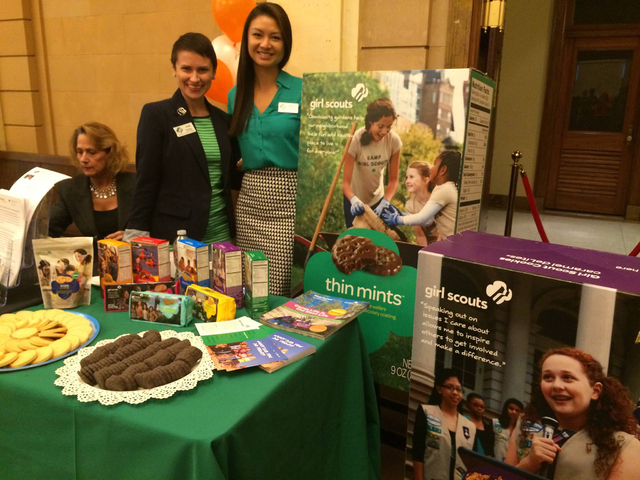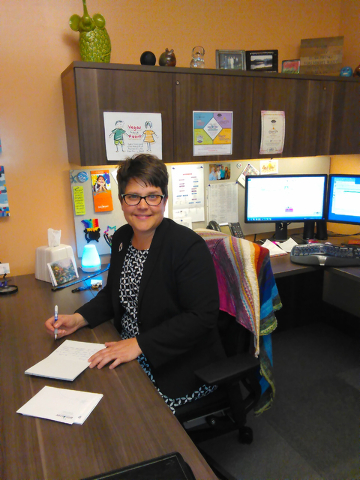Fundraisers best to think outside the box in today’s nonprofit world
Editor’s note: This is part two of a two-part series on starting a nonprofit in Las Vegas. The first story ran March 10. Visit viewnews.com.
Diana Morgan, director of development at the Discovery Children’s Museum, has words to work by posted near her desk: “Your crazy is showing. You might want to tuck that back in.”
As a fundraiser for small and large nonprofits, Morgan knows the drill of meticulous attention to detail — and the juggling of everything from planned giving to major gifts.
It’s not always a glamorous job. And for those who intend to start a nonprofit, Morgan offers this advice: Make sure no one else is doing what you’re trying to do.
“If you’re duplicating efforts, you’re going to run into difficulty fundraising,” she said.
DATA ANALYSIS IMPORTANT PART OF PLAN
Chris Stream, associate professor and director of UNLV’s School of Environmental and Public Affairs, agreed. When it comes to some nonprofit startups becoming aware of what others are already doing, he said, “They don’t often communicate well amongst themselves. There’s not a lot of dollars in our community to support every single thing, so, it becomes a challenge.”
There’s also the need for basic governing and budget skills, as well as the struggle to describe a nonprofit’s niche, with numbers that tell a story about solving a problem.
According to Stream, that last piece makes the difference when approaching institutions such as banks.
“They want to see the needle move, and you can only do that with really good data collection and data analysis,” he said. “The majority of our nonprofits don’t focus on that part of their plan.”
Many of those same nonprofits don’t build the capacity and the accounting ability to handle a large donation, even if it came their way, Stream added.
His advice to nonprofit startups is to show that there is infrastructure in place and performance measurements to help make decisions about how to be effective.
Statistics are critical when dealing with high-end donors, corporations or foundations, said April Mastroluca, president of the Association of Fundraising Professionals Las Vegas Chapter. Having a good story and being transparent both help, she said, adding that telling an emotional story may sometimes be enough for general donors and friends.
“One of the hardest things to quantify in a nonprofit is showing that what you’re doing is making a difference,” she said.
Her advice: Show the problem, show the solution and then show how your solution is changing the outcome.
APPROACH FUNDRAISING LIKE INVESTMENT PORTFOLIO
Morgan advises nonprofit newbies to approach the work of finding sustenance as if it were an investment portfolio. One might blend grant funding, individual donations, special events and corporate money.
“If you only use one tactic, you run the risk of hurting yourself in the long run,” she warned.
A case in point are grants, which are a fairly stable source of funding, she said, except in recessions.
According to Morgan, corporate money has also declined since the last recession.
“And it’s not coming back,” she said.
So, turn to the tried and true, she said, but throw in something new, too.
“If you’ve never tried crowdfunding before, like Nevada’s Big Give, give it a shot,” Morgan said. “But don’t let it be the only thing you do.”
Nevada’s Big Give is a 24-hour, online, statewide giving extravaganza that took place March 10 for a sixth consecutive year. Among its goals: making “giving where you live” easy and fun.
It also demonstrates that in a world where the paparazzi don’t usually chase the fundraisers, small nonprofits can still be mighty.
Morgan is president of the board at NevadaGIVES, a small, volunteer-powered nonprofit that coordinates the Big Give, with help from a part-time administrator. Last year, the event raised more than $570,000, reaching about 5,000 donors, according to board member Stacey Wedding, who brainstormed the idea.
This year, the event raised $638,821 for 335 nonprofits, using the Razoo online platform, Morgan said.
CROWDFUNDING CAN REACH A YOUNGER AUDIENCE
Crowdfunding tools such as Razoo have their good points, she explained: They reach a younger audience than direct mail; they create a healthy sense of urgency; they’re inexpensive; and “They’re also fun. That really can’t be underestimated.”
They also require time and energy spent in marketing to be effective. Last year, said Wedding, not all of the estimated 423 participating nonprofits raised money.
“You can’t just put something out there and watch it and expect it to do something,” said Morgan, who noted that NevadaGIVES spent months preparing just for the giving event.
That meant hounding corporate casino offices for sponsorships to provide prizes and cover expenses — and wrestling down every bit of available media exposure to get the word out.
HOLDING ON TO DONORS A STRUGGLE
According to Wedding, online giving is the highest-growing segment of philanthropy. But the biggest national trend is a plummeting figure for holding on to donors.
“The statistic on a national level is something, like, after a donor gives the first year, only 25 percent return to give a second year,” she said.
Wedding attributes that to the tendency of some nonprofits to sink too much time into the “newest, latest, greatest” fundraising fads, failing to tend to nuts-and-bolts activities such as putting donors in the database and making sure that contact isn’t just asking for something.
To help donors get invested long term, Morgan believes in the power of “thank you.”
“Not every time you talk to someone should be an ask,” she said. “In fact, you should thank people probably seven or eight times for every time you ask.”
Showing that you’re using money wisely and for its intended purpose also makes a deep impression. So does sharing — whether failure or success.
And, when you ask for money and get a “no,” Morgan added, “that’s not the end of the relationship.”
For nonprofits in their first year, she recommends focusing on gathering a core group of annual fund providers, which might come through grants, corporate sponsors or direct asking. Shoot for having next year’s budget covered.
If there’s something left over, think about adding programming or building a more sophisticated system to track the people who use your services.
If you can afford to do a pilot that shows you’ve done your homework and your concept gets results, do it, she said. That may open the door to major funding. Pulling together a good board that can help hatch solutions, fundraise and network your organization into higher realms of funding can also make a big difference.
And don’t ever depend on spellcheck. Morgan said she has seen some “unfortunate” mishaps — such as the interchanging of “prostate” and “prostrate.”


















